
Universal Micro Thermal Core Goobuy UC-541 is a highly versatile, 21x21mm micro thermal imaging core designed for space-constrained embedded applications. Unlike USB cameras restricted by cable length, this module outputs standard Analog Video (CVBS), allowing for long-distance transmission via coaxial cable (>100m) or instant integration into handheld night vision scopes, industrial pipe crawlers, and helmet-mounted wearables with zero video latency.
The Goobuy UC-541 is a 21×21 mm, 22 g ultra-light CVBS thermal imaging camera module designed for FPV drones, UAV inspection, robotics and embedded systems requiring real-time low-latency thermal vision with strict SWaP (Size, Weight, Power) constraints.
Engineered for FPV drones and UAVs, the Goobuy UC-541 thermal camera combines a miniature 21×21 mm footprint, ultra-light 22 g weight and analog CVBS output to deliver real-time thermal video with virtually zero latency. Offering multiple resolution options—256×192, 384×288, 640×512 and 1280×1024—it supports LWIR (8–14 µm) thermal imaging for night flight, smoke penetration, energy inspection and robotic navigation where visible-light cameras fail.
Its CVBS PAL/NTSC analog interface ensures seamless integration with FPV flight controllers, OSD boards and analog VTX systems, while OEM/ODM options include customizable lenses (4 mm / 9.x mm), housing, and cabling for professional UAV, robotics and industrial thermal-vision solutions.
The Goobuy UC-541 Thermal Imaging Camera Module is a 21×21 mm, 22g ultra-light solution that delivers low-latency analog CVBS output (PAL/NTSC), making it an excellent fit for FPV drones, autonomous robots, and energy monitoring systems.
Unlike digital modules, its analog CVBS video ensures near-zero delay, ideal for real-time FPV navigation and inspection flights. With support for multiple color palettes, robust thermal sensitivity, and flexible integration, it provides engineers with an affordable and practical tool for embedded thermal vision.
21*21mm Mini CVBS thermal camera modules (256*192, 384*288, 640*512, 1280*1024, analog output) are ideal for drones, UAVs, and FPV systems where low latency, analog transmission is preferred over digital for real-time monitoring.The core advantages of the 22g ultra-light CVBS thermal imaging module (4 resolutions) are its extreme weight and high integration, making it a revolutionary solution for scenarios where weight and space are critical
Thermal Imaging (Uncooled Microbolometer): This core technology detects infrared radiation (heat) rather than visible light.
Solves: The inability to see in complete darkness, through smoke, fog, light dust, or certain thin materials. It also detects invisible temperature anomalies (hot/cold spots) and enables non-contact temperature measurement.
Meets Demand: Enhanced situational awareness in challenging visual conditions; predictive maintenance (identifying overheating components); security in absolute darkness; process control based on temperature; fire detection.
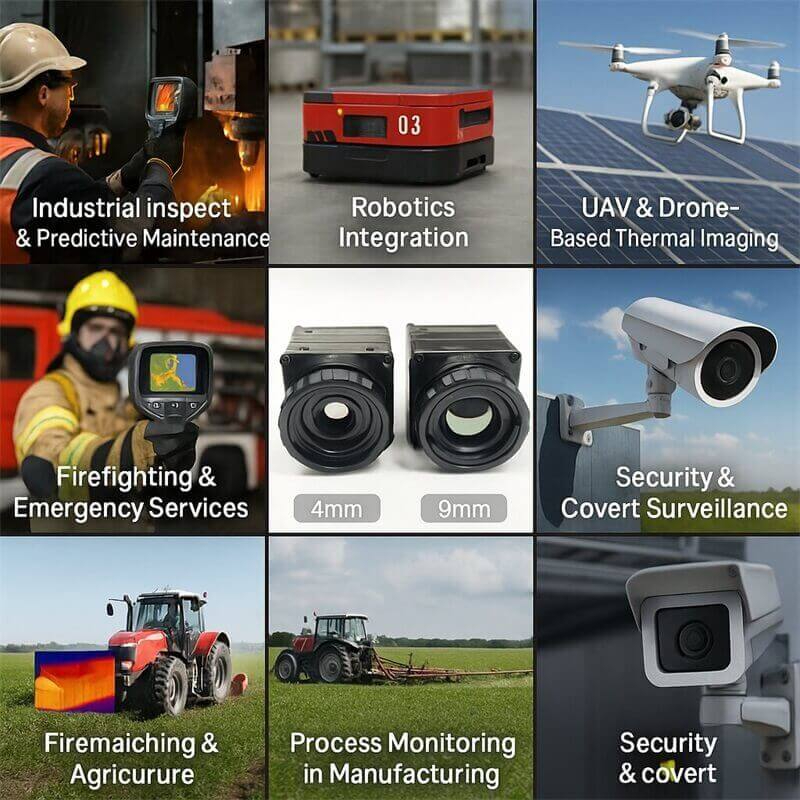
Product Features
✔ Various Resolution Thermal Imaging: Detect minute temperature differences
✔ 21*21mm Module Size: Suitable for tight embedded integration and FPV drone
✔ Real-Time IR Output: For immediate monitoring and AI analysis
✔ Customizable Interface: USB, CVBS, AV options
✔ OEM Ready: 4mm and 9mm lens available
Engineering Advantage: Why Choose Analog (CVBS) in 2025?
While digital interfaces (USB/MIPI) are popular, Analog CVBS remains the superior choice for specific engineering challenges:
Long-Range Transmission: Transmit video over 100+ meters of low-cost coaxial cable (vs. 3m limit for USB).
Zero Latency: No digital encoding/decoding delay. What happens now, you see now. Crucial for driving/piloting.
Simplicity: No drivers, no OS compatibility issues (Linux/Windows/Android). It works like a TV—plug it in, and the image appears.
Low Power: Consumes significantly less power than digital processing boards, extending battery life in portable devices.
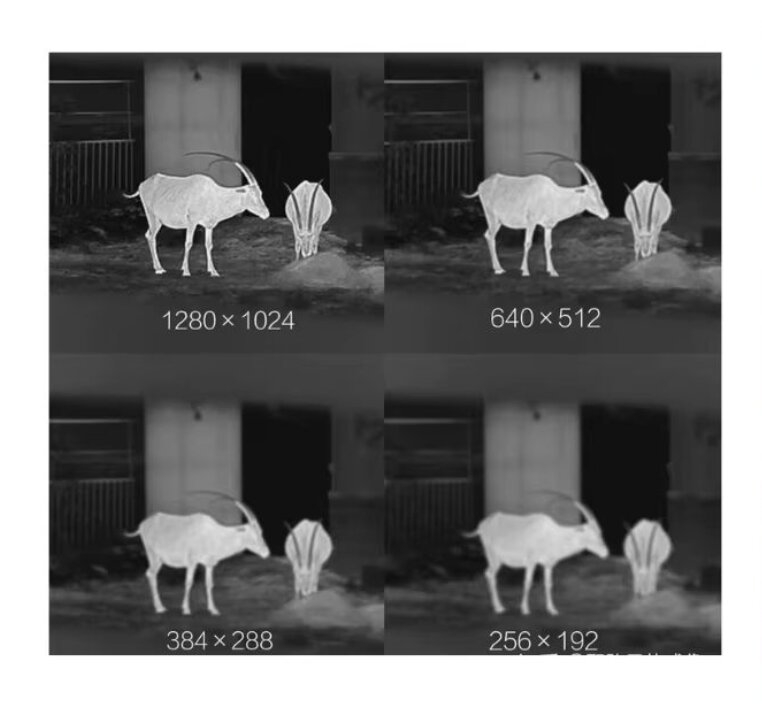
Note: This version is non-radiometric (video-only, no temperature measurement)
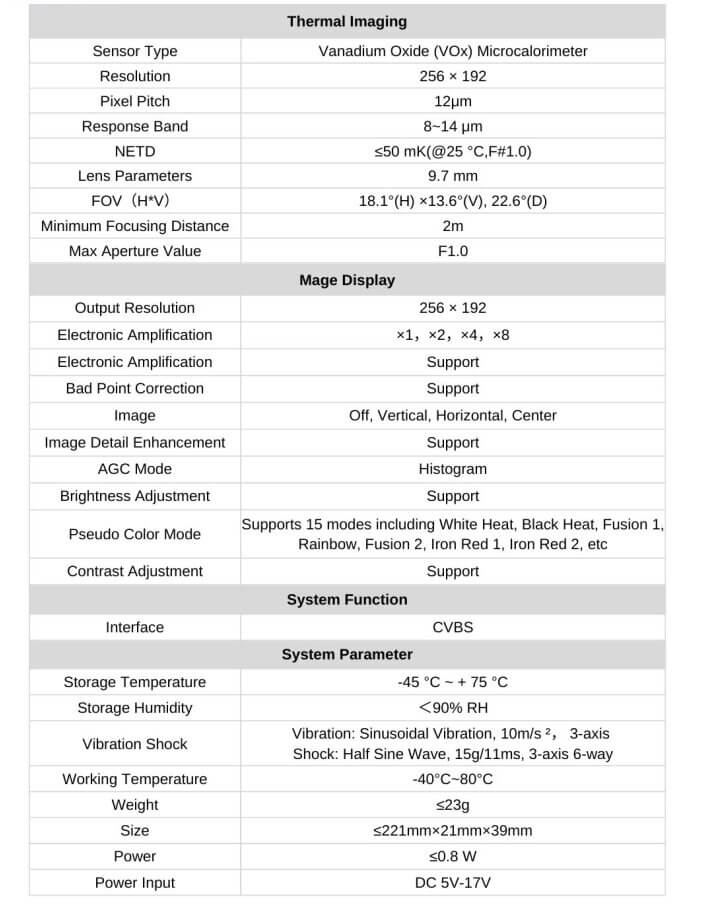
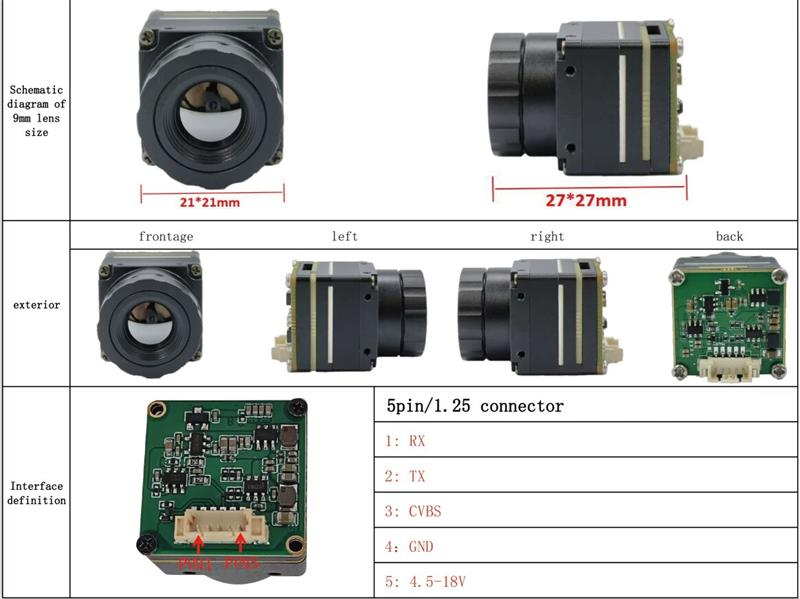
compare real video screenshot between 640*512 EFL 9.1mm lens thermal camera and 256*192 EFL 3.1mm lens thermal camera
( picture had been compressed much)
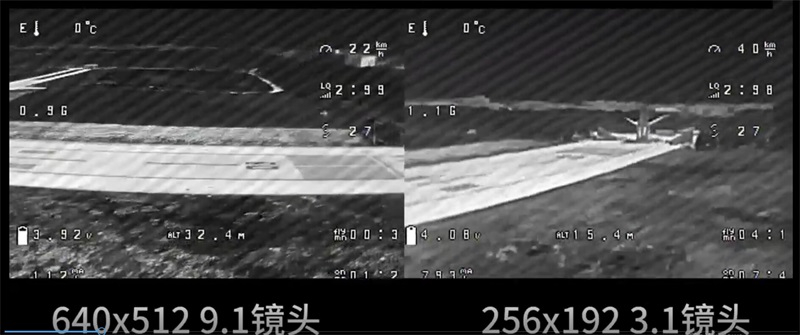
| Output Type | CVBS Thermal Camera | HDMI Thermal Camera | USB Thermal Camera |
|---|---|---|---|
| Latency | Ultra-low (near-zero) | Low | Medium |
| Image Quality | Low–Mid | High–Very High | High |
| Resolution Range | 256×192 → 640×512 | 256×192 → 1280×1024+ | 256×192 → 1280×1024+ |
| Interface | Analog PAL/NTSC | Digital HDMI | Digital USB/UVC |
| Best For | FPV drones, real-time piloting | Display/monitor systems | Robotics, embedded vision |
| Integration Difficulty | Very low | Medium | Medium–High |
| Weight Impact | Lowest (simple circuitry) | Medium | Medium |
| Processing Required | None / minimal | Minimal | Higher (software needed) |
| Cable Length | Long, low sensitivity | Short–Medium | Short |
| Use Case | Real-time flight, low latency navigation | Thermal monitors, surveillance | AI edge devices, robotics, analysis |
Application Scenarios
A. FPV Drones & UAV Night Flight
Ultra-low latency CVBS thermal feed for pilots; ideal for night flying, smoke conditions, fog penetration and thermal-signature tracking.
B. Industrial UAV Inspection
Detect thermal anomalies on solar panels, power lines, substations, wind turbines, especially under low-visibility or harsh environments.
C. Robotics & Autonomous Navigation
Embedded thermal vision for robots operating in dark rooms, tunnels, firefighting scenarios and low-visibility environments.
D. Energy & Infrastructure Monitoring
Detect overheating components, electrical faults, insulation failures, and heat leaks that standard visible cameras cannot detect.
E. Search & Rescue
Identify human heat signatures in darkness, smoke, debris, forests, and disaster zones.
F. DIY Handheld Night Vision & Thermal Monoculars
Scenario: Outdoor enthusiasts, hunters, and makers building their own portable thermal scopes or upgrading existing optical sights.
Why this module? The CVBS output connects directly to miniature viewfinder screens (LCOS/OLED micro-displays) without complex processors. The 21mm size fits perfectly inside 3D-printed housings or rifle scope attachments.
G Industrial Pipe Crawlers & Sewer Robots
Scenario: Inspecting sewage pipes, HVAC ducts, or oil pipelines where lighting is impossible and cables must be long.
Why this module? USB signals fail after 3-5 meters. CVBS analog signals can travel hundreds of meters over coaxial cable without latency, making this module ideal for tethered inspection robots operating in dark, narrow tubes.
H. Covert Security & Mini-CCTV
Scenario: Hidden surveillance in ATMs, smart doorbells, or border monitoring sensors.
Why this module? The tiny lens (pinhole-like size available) and board allow it to be disguised easily. It detects body heat even in absolute darkness where hidden visual cameras fail.
Your Target Customers
- Industrial Automation Integrators
- Robotics and Drone OEMs
- Smart Building & HVAC Solution Providers
- Security Camera and Surveillance Developers
- Medical Device Manufacturers
- AI & Embedded Vision Startups
what troubling problems it can solve in Drone / FPV / UAV application?
This micro CVBS thermal camera module is a game-changer for drone, FPV (First Person View), and UAV applications, particularly where minimal weight, real-time video, and all-conditions visibility are essential.
Problems Solved:
Special Demands Met:
Engineer-Focused FAQ
Q1. Why does this Goobuy UC-541 thermal module use analog CVBS instead of digital?
Because CVBS provides near-zero latency, making it ideal for FPV and UAV piloting where delay can be dangerous or unusable.
Q2. What makes the Goobuy UC-541 suitable for drones?
Its ultra-light 22 g weight, compact 21×21 mm size, low power, and real-time analog output make it perfect for lightweight airframes.
Q3. Does this Goobuy UC-541 thermal camera work in complete darkness?
Yes. It uses an 8–14 µm LWIR sensor that detects thermal radiation, not visible light. It works in total darkness, fog, smoke and dust.
Q4. What thermal imaging resolutions of Goobuy UC-541 model are available?
You can choose from: 256×192, 384×288, 640×512 or 1280×1024, depending on detail and budget requirements.
Q5. Can this Goobuy UC-541 module be integrated into robotics systems?
Absolutely. It supports embedded integrations where compact size and low latency thermal vision are required.
Q6: Can I use this UC-541 to build a thermal hunting scope?
A: Yes. The module can drive a micro-display directly via the AV input. You just need a battery, a lens, a screen, and a housing.
Q7: Does it work with Raspberry Pi or Arduino?
A: For Raspberry Pi, you will need a USB Video Grabber (AV to USB). However, for direct display on screens, no microcontroller is needed.
Q8: Can this camera see through walls?
A: No thermal camera can see through walls. However, it can detect heat leaks or insulation gaps on the wall surface, which is useful for home inspection.
Q9: What is the pinout for connection?
A: Standard 3-pin or 4-pin: Power (VCC), Ground (GND), Video (Signal), and optional OSD Control.
Feedback and comment from our customers
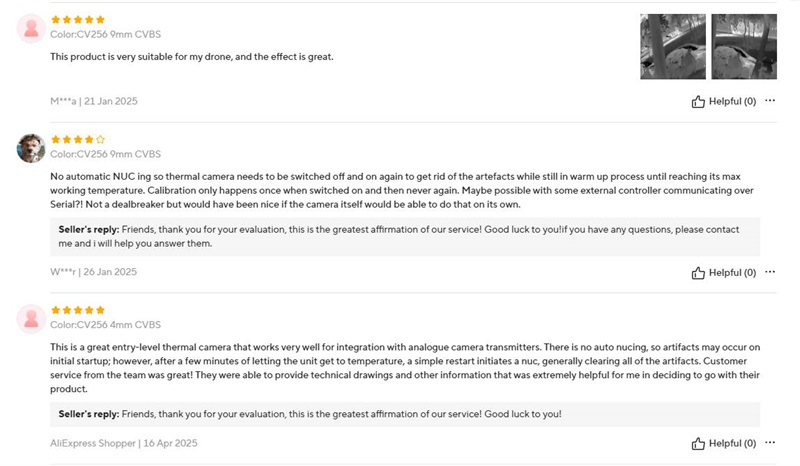
Relative blogs and product application articles
1, Thermal Cameras Boost ROI in Maintenance
2, Thermal Imaging Success Stories in U.S., Germany, UK
3, Micro Thermal Camera: SWaP Solutions for U.S. & Europe